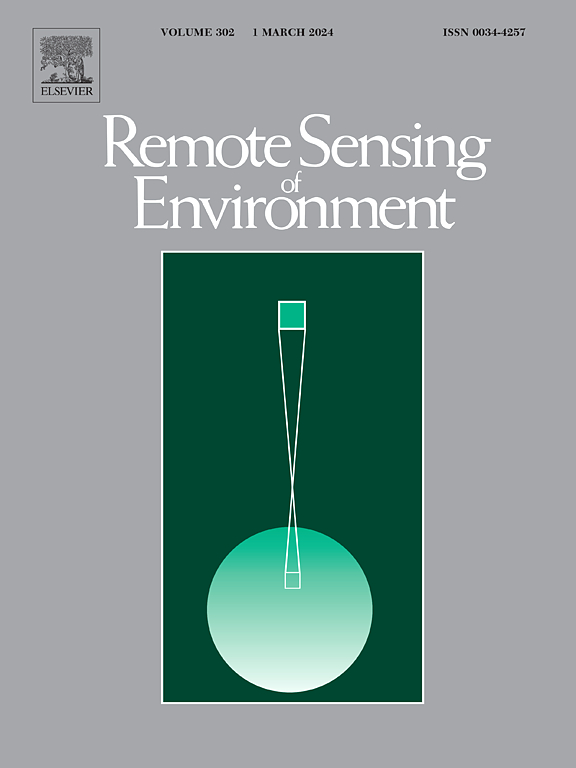Application of satellite and proximal hyperspectral sensing to target lithium mineralization in volcano-sedimentary deposits: A case study from the McDermitt caldera, USA
IF 11.1
1区 地球科学
Q1 ENVIRONMENTAL SCIENCES
引用次数: 0
Abstract
This study provides satellite and proximal hyperspectral analyses of lithium (Li)-bearing volcano-sedimentary environments aimed at determining the target absorption features of alteration assemblages to be used as exploration vectors towards analogous Li-mineralized systems.
The study was applied at the McDermitt caldera (USA), which hosts volcano-sedimentary Li mineralization in the form of clay minerals originated from the alteration of glass-rich extrusive igneous rocks in endorheic lacustrine basins. The surface-exposed areas of the caldera were investigated using satellite hyperspectral imagery acquired by the German Environmental Mapping and Analysis Program (EnMAP) mission. Satellite data were validated via ground spectroscopy, performed through hyperspectral imaging, complemented by mineralogical and geochemical analyses on specimens deriving from the Jindalee McDermitt Li deposit.
The Li mineralization in the Jindalee McDermitt deposit is dominated by a Mg(Li)-smectite (hectorite) + amorphous silica assemblage, showing absorption features at 2306 nm and 2200 nm that can be detected in the spectral range covered by the EnMAP sensor. The analysis of the corresponding hyperspectral feature distribution maps and the comparison with ground control samples, confirmed that the above features together can be effectively used as mineralogical-hyperspectral vectors for Li-prospective areas on a caldera-scale. This spectral footprint was used in the analysis of a similar system that lacks Li mineralization (High Rock caldera complex, USA). Results of this test show that the distinctive 2200 + 2306 nm bands association is lacking at the High Rock caldera complex, which suggests that this spectral footprint can be employed as a mappable criteria to target lacustrine sequences with mineralogical features analogous to those of Li-mineralized volcano-sedimentary deposits.


卫星和近端高光谱遥感在火山-沉积矿床锂矿化中的应用:以美国麦克德米特火山口为例
本研究提供了含锂火山-沉积环境的卫星和近距离高光谱分析,旨在确定蚀变组合的目标吸收特征,并将其作为类似锂矿化系统的勘探向量。该研究以美国麦克德米特火山口为研究对象,该火山口以黏土矿物形式存在火山-沉积Li矿化,这些黏土矿物来源于内陆湖相盆地富玻璃喷出火成岩的蚀变。利用德国环境测绘和分析计划(EnMAP)任务获得的卫星高光谱图像,对火山口的表面暴露区域进行了调查。卫星数据通过地面光谱进行验证,并通过高光谱成像进行验证,同时对来自Jindalee McDermitt Li矿床的标本进行矿物学和地球化学分析。Jindalee McDermitt矿床的Li矿化以Mg(Li)-蒙脱石(hectorite) +无定形二氧化硅组合为主,在2306 nm和2200 nm处表现出吸收特征,可在EnMAP传感器覆盖的光谱范围内检测到。通过对相应高光谱特征分布图的分析以及与地面对照样品的对比,证实了上述特征可以有效地作为火山口尺度锂矿远景区矿物学-高光谱矢量。该光谱足迹被用于分析一个类似的缺乏锂矿化的系统(High Rock火山口杂岩,美国)。结果表明,高岩火山口杂岩中缺乏2200 + 2306 nm的独特波段组合,这表明该光谱足迹可以作为一种可测标准,用于定位具有类似锂矿化火山沉积矿床矿物学特征的湖相序列。
本文章由计算机程序翻译,如有差异,请以英文原文为准。
求助全文
约1分钟内获得全文
求助全文
来源期刊

Remote Sensing of Environment
环境科学-成像科学与照相技术
CiteScore
25.10
自引率
8.90%
发文量
455
审稿时长
53 days
期刊介绍:
Remote Sensing of Environment (RSE) serves the Earth observation community by disseminating results on the theory, science, applications, and technology that contribute to advancing the field of remote sensing. With a thoroughly interdisciplinary approach, RSE encompasses terrestrial, oceanic, and atmospheric sensing.
The journal emphasizes biophysical and quantitative approaches to remote sensing at local to global scales, covering a diverse range of applications and techniques.
RSE serves as a vital platform for the exchange of knowledge and advancements in the dynamic field of remote sensing.
 求助内容:
求助内容: 应助结果提醒方式:
应助结果提醒方式:


